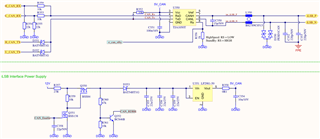Other Parts Discussed in Thread: TCAN1057A-Q1
Tool/software:
Hello,
In our designs we usually use the NXP TJA1050 CAN Transceiver. For a short while now we are using the TI SN65HVD1050 as a replacement and problems seem to arise from this change.
Given operating conditions:
We are triggering our controller to boot loader mode via special CAN messages. Thus, the controller resets and clears the needed flash pages. Due to safety reasons, our circuit disables the power supply of the CAN transceiver during flash erase. Once done, the boot loader re-enables the transceiver supply and waits for 3ms (supply is OK after 1.5ms) until it tries to connect to the bus.
Observation - bad case (SN65HVD1050):
After powering up the transceiver, messages on the bus get through to the RX-Pin after approx. 30ms. See screenshot - yellow curve: 5V supply of transceiver; blue curve: Rx-Pin of the transceiver SN65HVD1050
With this the CAN-Controller transitions into bit-dominant-error and then to bus-off.

Observation - good case (TJA1050):
After powering up the transceiver, messages on the bus get through to the RX-Pin after approx. 2ms. See screenshot - yellow curve: 5V supply of transceiver; blue curve: Rx-Pin of the transceiver TJA1050

Questions:
Can anyone confirm, if there is some kind of delay circuit in the TI transceiver? And under which circumstances?
Is there a chance, that it might be a bug inside the transceiver?
Am I missing some features or conditions to be met before the transceiver starts?
Any ideas how to avoid it in the first hand (instead of just increasing the delay for continuing the transmission) ?
To make it clear: we have the possibility to change the software in a future release to work around this issue, but we need to fully understand the behavior. However, we have several devices out at the customers with this problem which get bricked by this behavior and need to get sent in for repair, which is more of a pain.
Hope anybody can help.
Best regards
Steve


